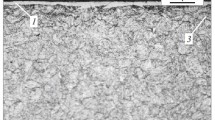This study developed a technological process of vacuum thermocyclic plasma nitriding, which improves the diffusion saturation rate and reduces energy consumption. The nitriding was carried out in a mixture of nitrogen and argon (25% N2 +75% Ar) for specimens from 18KhGT steel in the temperature range of 450–550 °C, pressure 50–100 Pa. The process duration ranged from 3 to 9 h. After nitriding, microhardness was evaluated. The study of 18HGT steel with a hardened nitrided layer allowed us to obtain experimental results to determine the regularity of the influence of diffusion saturation parameters on microhardness. The surface layer characteristics are determined, and the possibility of controlling them due to changes in the technological process parameters is shown. Based on the obtained experimental data, a mathematical model of the technological process of vacuum thermocyclic plasma nitriding of 18HGT steel was developed. Based on the mathematical model built on the results of experimental studies, the response surfaces of microhardness, which depend on the duration of the diffusion saturation process, process temperature, and pressure in the vacuum chamber, were created. A generalization of experimental studies of the formation of nitrided layers was carried out, which allowed us to determine the influence of technological modes of vacuum thermocyclic plasma treatment on the microhardness of 18HGT steel. The choice of optimal technological modes allowed us to increase the microhardness from 670 to 1100 kg/mm2.


Similar content being viewed by others
References
V. V. Bryukhovetsky, V. F. Klepikov, V. V. Lytvynenko, et al., “The structural phase state and strength properties of the surface layer of AA6111-T4 aluminum alloy irradiated by the high-current electron beam,” Nucl. Instrum. Meth. B, 519, 1–8 (2022).
M. A. Vasylyev, B. N. Mordyuk, S. M. Voloshko, V. I. Zakiev, A. P. Burmak, and D. V. Pefti, “Modification of surface layers of Cu–39Zn–1Pb brass at high-frequency impact deformation in the air and argon inert environments,” Metallofiz. Nov. Tekh., 42, No. 3, 381–400 (2020).
I. B. Ivasenko, V. M. Posuvailo, M. D. Klapkiv, V. A. Vynar, and S. I. Ostap’yuk, “Express method for determining the presence of defects of the surface of oxide-ceramic coatings,” Mater. Sci., 45, No. 3, 460–464 (2009).
M. M. Student, I. B. Ivasenko, V. M. Posuvailo, et al., “Influence of the porosity of a plasma-electrolytic coating on the corrosion resistance of D16 alloy,” Mater. Sci., 54, No. 6, 899–906 (2019).
V. M. Beresnev, S. A. Klimenko, O. V. Sobol, et al., “Effect of the deposition parameters on the phase- structure state, hardness, and tribological characteristics of Mo2N/CrN vacuum-arc multilayer coatings,” J. Superhard Mater., 38, No. 2, 114–122 (2016).
O. V. Man’ko and A. E. Stets’ko, “Kinetics of the diffusion chromium plating of steels with nickel-cobalt-phosphorus coating,” Mater. Sci., 55, No. 6, 870–877 (2020).
O. Bazaluk, O. Dubei, L. Ropyak, et al., “Strategy of compatible use of jet and plunger pump with chrome parts in oil well,” Energies, 15, No. 1, 83 (2022).
O. Y. Dubei, T. F. Tutko, L. Y. Ropyak, and M. V. Shovkoplias, “Development of analytical model of threaded connection of tubular parts of chrome-plated metal structures,” Metallofiz. Nov. Tekh., 44, 251–272 (2022).
Z. A. Duryagina, S. A. Bespalov, A. K. Borysyuk, and V. Ya. Pidkova, “Magnetometric analysis of surface layers of 12Kh18N10T steel after ion-beam nitriding,” Metallofiz. Nov. Tekh., 33, No. 5, 615–622 (2011).
Z. A. Duryagina, A. K. Borysyuk, S. A. Bespalov, and V. Ya. Pidkova, “Influence of the thermal cyclic treatment on the phase composition of ion-nitrided surface layers of 12Kh18N10T steel,” Mater. Sci., 48, No. 3, 364–368 (2012).
V. Tarelnyk, O. Gaponova, V. Martsynkovskyy, et al., “New method for nitrocarburizing steel parts,” in: IEEE 11th Int. Conf. Nanomaterials: Applications & Properties (NAP), (2021), pp. 1–8.
V. B. Tarelnyk and O. P. Gaponova, “Investigation of the formation processes of aluminized layers obtained by electrospark alloying. Part II. Mathematical model of the aluminizing process,” Metallofiz. Nov. Tekh., 41, No. 11, 1483–1498 (2019).
J. N. Feugeas, B. J. Gómez, L. Nachez, and J. Lesage, “Steel surface treatment by a dual process of ion nitriding and thermal shock,” Thin Solid Film., 424, No. 1, 125–129 (2003).
A. O. Khotsyanovskii, A. Yu. Kumurzhi, and B. A. Lyashenko, “Improvement of strength and wear resistance of metal products with ion-plasma nitride coatings by pulse technique implementation,” Strength Mater., 46, No. 3, 422–428 (2014).
Yu. S. Nalimov, A. V. Rutkovskii, S. G. Kisilevskaya, et al., “Effect of ion-plasma thermocyclic nitriding on the fatigue resistance of ChS70VI alloy,” Strength Mater., 52, No. 2, 262–267 (2020).
M. A. Dolgov, N. A. Zubrets’ka, A. V. Buketov, and P. D. Stukhlyak, “Use of the method of mathematical experiment planning for evaluating adhesive strength of protective coatings modified by energy fields,” Strength Mater., 44, 81–86 (2012).
L. Ropyak, and V. Ostapovych, “Optimization of process parameters of chrome plating for providing quality indicators of reciprocating pump parts,” Eastern-European Journal of Enterprise Technologies, 2, No. 5 (80), 50–62 (2016).
M. Bembenek, O. Popadyuk, T. Shihab, et al., “Optimization of technological parameters of the process of forming therapeutic biopolymer nanofilled films,” Nanomaterials, 12, No. 14, 2413 (2022).
H. Ju, L. X. Li, Q. Wang, and J. P. Diao, “Optimum design of the gas nitriding technological parameters of H13 steel,” J. Funct. Mater., 42, 405–407 (2011).
V. V. Nalimov and N. A. Chernova, Statistical Methods of Planning of Extreme Experiments [in Russian], Nauka, Moscow (1965).
Author information
Authors and Affiliations
Corresponding author
Additional information
Translated from Problemy Mitsnosti, No. 5, pp. 71 – 78, September – October, 2022.
Rights and permissions
Springer Nature or its licensor (e.g. a society or other partner) holds exclusive rights to this article under a publishing agreement with the author(s) or other rightsholder(s); author self-archiving of the accepted manuscript version of this article is solely governed by the terms of such publishing agreement and applicable law.
About this article
Cite this article
Dolgov, N.A., Rutkovskyi, A.V. Structural Steel Microhardness Improvement by Ion Nitriding. Strength Mater 54, 819–824 (2022). https://doi.org/10.1007/s11223-022-00458-4
Received:
Published:
Issue Date:
DOI: https://doi.org/10.1007/s11223-022-00458-4




